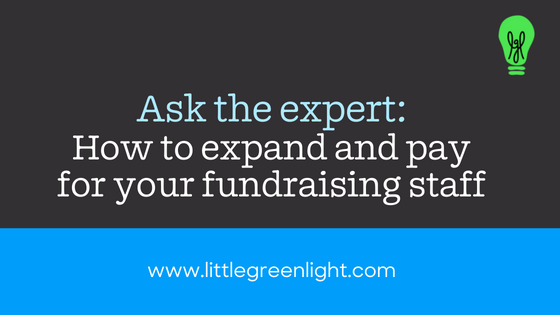Little Green Light is a cloud-based donor management system for fundraisers.
Subscribe to get our latest product updates, best practices and tips to grow your nonprofit.

To raise more money for your organization, you may need to expand your fundraising staff. But what’s the right position to add, and how do you pay for it? Thankfully, we have some expert advice for you. When Little Green Light hosted its Meet the Author webinar with author Erik Hanberg, attendees submitted so many great questions for the Q&A portion that we couldn’t answer them all in our allotted time. But, Erik was able to respond to additional questions on our blog. We’re excited to continue sharing his practical nonprofit expertise with you in our Ask the Expert series.
In this post, Erik offers advice on how to expand your fundraising staff—and how to pay for it.
Hi Paige,
Great question! It really depends on the size of your nonprofit right now. If you are like the many many small nonprofits out there, I’m guessing that a lot of the fundraising is falling on you, or a small group of folks who aren’t professional fundraisers. That’s fine. It’s normal!
The first thing to know is that you shouldn’t expect to hire a professional fundraiser to come in and do everything for you. So don’t go looking for a “director of development” as your first development hire when you expand your fundraising staff. Start at the bottom and work your way up. I think a good hire to consider is a part-time or full-time “development coordinator.” This position might process monthly donations, send out thank-you letters, enter some donor data, coordinate an envelope stuffing party, and format fundraising emails. This position might also provide support for events like a fundraising breakfast.
If you are doing good fundraising work, this position will take a lot of the administrative load off you. But you should not meaningfully reduce your time spent fundraising! Instead, use it to continue cultivating major donors, writing the annual appeal, and other relational work that a development coordinator isn’t suited for.
If you haven’t already, I recommend reading The Little Book of Gold (which is available to Little Green Light customers for free in 2022!) to get a sense of some of the professional fundraising activities you might be focused on. A full-time Executive Director should be able to make time for major donor asks, sending out an annual appeal, and planning a fundraising breakfast.
Having a development coordinator around to help will make these fundraising activities go much better. And because they are high-reward fundraising activities, their benefits will grow quickly!
But I want to be clear that the staff leadership of your nonprofit (whether that’s you or someone else) should still be the fundraising lead, not the development coordinator.
Good luck!
Erik
Hi Maggie,
I hate to be the bearer of bad news. But asking donors to fund staff is not going to be a framing that resonates with donors. Donors want to fund impact.
Let’s say you have a staffing level to serve 100 clients a month. Your best case to your donors is likely framed around:
Focus on the impact of your work as much as possible.
There’s a saying in fundraising that “people give to people to help people.” Let’s translate that to this situation: Your donors give to you to help your clients (or customers or patrons). But if they start to feel like they are giving to help you, you’re going to lose them.
All that said, there may be one area where you can find donations to grow your staff. Some foundations invest in “capacity building,” which can translate to new staff or technology purchases if they can help you level up. To use the above example, if you could make a case for a new staff member to get you from 100 clients/month to 200/month, a “capacity building” grant might be a great tool. But these are likely pretty limited in scope (or, if they’re larger in scope, they’re harder to get). They also usually go away or get smaller after the big initial investment. The idea is that the grant helps you deliver a program that opens up new revenue sources.
I hope that helps your thinking on how to approach donors or foundations. Good luck growing your organization!
Erik
If you missed our webinar with Erik, be sure to check it out here. And, if you’re looking for more great advice, we encourage you to read Erik’s book, The Little Book of Gold. Forbes rated it as a Top 12 Must-Read Book for Nonprofit Employees, and it’s full of practical, actionable fundraising wisdom.
If you’re using Little Green Light, we also want to point you to LGL’s Companion Guide to The Little Book of Gold. Each chapter of Erik’s book covers an essential aspect of fundraising, like how best to expand your fundraising staff. In our Companion Guide, we’ve written corresponding chapters to show you how to use Little Green Light to implement Erik’s advice.
Download a FREE digital copy of The Little Book of Gold here, along with LGL’s Companion Guide (available further down on the same page).
Your free digital copy of The Little Book of Gold is available throughout 2022.
Ready to try LGL? Get your first 30 days free. No credit card required.